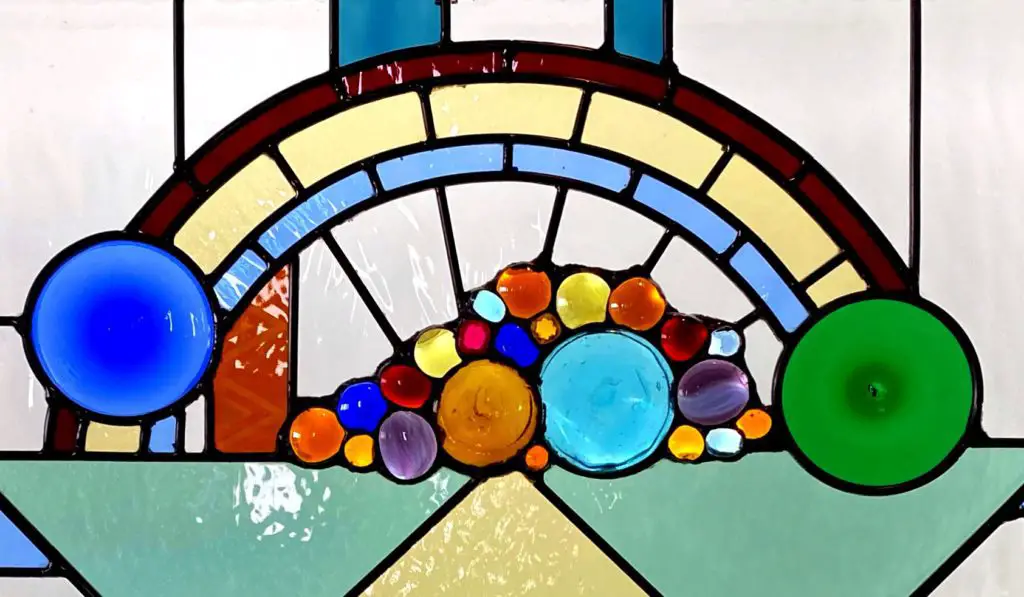If you grew up in America prior to 1978, you probably remember your parents telling you not to eat the paint chips. At the time, children were slowly and secretly developing lead poisoning, which caused severe developmental issues. Though lead paint has been done away with for decades now, lead is still used in the production of stained glass.

Is lead in stained glass dangerous?
The answer is – not really. Leaded stained glass poses more of a health risk to manufacturers than it does to homeowners. That is because the lead used in stained glass is only really dangerous if directly inhaled or ingested. So, the lead glass in your home won’t cause issues unless you have adventurous children who lick the glass.
While it’s clear that lead on its own is dangerous, there’s a major difference between ingesting lead and simply being around it. So, we’re going to go into great detail about what the dangers of lead really are and whether or not leaded glass is actually dangerous. Read on for info updated in 2024.
The dangers of lead
Lead is a metal that’s used to make products like pipes, batteries, and even pottery. Lead is also used in the production of stained glass, particularly in lead solders and cames. That’s why the production of stained glass can be harmful to artists.
When you breathe in or ingest lead particles, the lead levels in your body slowly begin to build up. While that’s happening, you’re likely going to experience signs and symptoms that tell you something’s amiss. Yet, a diagnosis of lead poisoning is very easy to overlook.
For a detailed discussion of the effects of lead, and for precautions to take when using lead crystal decanters and wine glasses, please read this post.
New – update on UK lead water pipes
Australian warning on lead in paint
This comprehensive publication from Australia explains how lead can be dangerous for men, women, and children—especially young children and pregnant or breastfeeding women.
Homes built before 1970 are most at risk, but those built more recently may also have paint
containing lead.
If you are renovating or repainting your home, or if you live in a home built before 1970 with
flaking or peeling paint, read this booklet for more information.
As an Amazon Associate, I earn from qualifying purchases
When lead becomes dangerous
Just touching lead isn’t dangerous on its own, but it can be dangerous if you follow up by putting your fingers in your mouth. Lead is also incredibly dangerous when breathed in (inhaled) or ingested in some way (swallowing, chewing, biting, etc.).
Any effects that we’re about to go over are related to these specific interactions with lead, not simply touching lead or being in close proximity to it.
Physical effects
The physical effects of lead poisoning will set in slowly. So slow that you probably won’t even attribute your symptoms to lead poisoning or stained glass.
You might begin to experience gastrointestinal issues like stomach pain, constipation, or even a lack of appetite. In the long term, this can lead to weight loss or further issues.
Headache and fatigue are also pretty common. You might notice that you don’t have as much energy as you usually do or that there’s a nagging pain in your head that never seems to go away with Advil.
When the physical effects continue, you might begin to feel tingling in your extremities (hands and feet). If you’re pregnant, there’s a huge possibility that your lead poisoning will also impact your unborn baby’s development.
Mental Effects
Lead poisoning also has pronounced effects on the brain and the central nervous system. That’s because the lead actually attacks these systems and then impairs their ability to work properly.
So, you might begin to develop memory loss or amnesia, not able to remember things from 10 minutes ago or three weeks ago. There’s also a chance that your mood might be impacted, as irritability is a pretty common symptom too.
In children, the emotional and mental effects are even more severe. Because the brains of children are still developing, it’s not unusual for lead poisoning to impact a child’s behavior or learning processes.
This can lead to learning disabilities or behavioral disorders in the long term.
These disabilities have been shown by Nevin to have extremely serious effects in later life, leading to dramatic increases in anti-social behavior, violent crime, and even murder:


The relationship between stained glass and lead
Even though stained glass is made with the same lead that can cause lead poisoning, how you interact with your stained glass will determine whether or not there’s a health danger. So long as you’re not inhaling or ingesting the lead, you shouldn’t experience negative consequences.
However, you must take the necessary precautions to keep your leaded glass away from children and pets. After all, both children and pets are more likely to get a little mischievous when left alone. So, we will touch on some key ways to avoid lead exposure when you have stained glass in your home.
Possible dangers
There’s no doubt that the process of making stained glass is potentially dangerous when it comes to the lead used. Stained glass workers sometimes spend hours on end breathing in dangerous lead particles, significantly increasing their risk of lead poisoning.
However…
Having leaded stained glass in your home is not an issue on its own. Leaded glass does become a potential health danger when it’s either ingested or inhaled. In a home full of adults or grown children, this shouldn’t be an issue.
However, just like children are known to chew on woodwork and eat lead paint, don’t be surprised if you find your toddler licking or biting your stained glass. This is where the dangers of lead come into play, which puts your children at risk for brain damage.
Keeping your family safe
Since most stained glass has some form of lead used in its creation, you have two options: Get rid of the stained glass or develop a plan to keep your children safe.
If you’re still reading, it’s probably because you’ve decided that your beautiful stained glass isn’t going anywhere.
Whether it’s just too large to remove, it’s a key focal point of your home, or if it’s physically installed as a window, it’s your right to keep it! So, let’s go over what you can do to keep your family safe with leaded glass in your home.
- Dust your stained glass. When too much dust begins to build up in your home, it settles on just about any surface it can find. That includes your stained glass. If the dust on your stained glass is suddenly breathed in, it could also transmit lead into a person’s lungs. So, do your best to dust as often as possible and avoid allowing dust to build up.
- Clean your stained glass. Dusting will get rid of any light residue, but a deeper clean might ease your mind a bit more when it comes to keeping your children safe. Combine a solution of water and gentle dish soap and carefully clean your stained glass with a damp cloth. Plus, it’ll make your stained glass look even prettier year-round.
- Keep stained glass out of reach. When you have young children and pets, you know they find their way into just about everything. If you have small stained glass panels, make sure you’re hanging them up high on the walls or on a counter where your children can’t reach them.
- Keep an eye on your children. If you only have stained glass in certain areas of your home, you should supervise your children closely when they’re in these areas. Remind your children that stained glass is neither a toy nor a tasty snack.

Just because you have leaded glass in your home doesn’t mean that you have to get rid of it when you have children or pets. You just have to make sure that you’re careful and proactive to keep your family safe too.
Not sure if your window is made with lead?
Use a lead-testing kit like this one available at Amazon
Conclusion
The lead you find in stained glass is absolutely the same lead that’s described as causing lead poisoning. However, in normal circumstances, the lead in stained glass isn’t a health risk to most people.
Lead poses the greatest risk to young children and pets, especially when it’s breathed in or ingested (licked, chewed, bitten, etc.). To avoid lead poisoning when you have stained glass in your home, make it a point to dust and clean your stained glass while also keeping it out of reach from your children.
Case study – beveled glass safety

Artistry in Glass is pleased to have reassured our customer in Florida who was concerned about the safety of her family. Read the interesting post here.
Glass safety – learn from the experts!
- Choosing between tempered & laminated glass
- Broken glass injuries and how to avoid them
- Is wired glass safe?
- What is safety glass?
- What is tempered glass?
- What is Gorilla Glass?
- Plexiglass vs glass
- Should glass shelves be tempered?
- Should glass tabletops be tempered?
- Is lead crystal dangerous?
- Is leaded (stained) glass dangerous?
- How to repair cracked stained glass
Unique Mirror Resources from Artistry in Glass
Mirror Design & layout
- How are mirrors made?
- What is a beveled mirror?
- What is a two-way mirror?
- Best mirrors for bedrooms
- How to size and position your wall mirror
- How to order custom etched mirrors
- Best places to hang dining room mirrors
- How much do wall mirrors cost?
- Shop the MIRROR Family Package
Mirror Installation & Removal
- How to hang a wall mirror
- How to frame a builder’s grade bathroom mirror
- How to hang a frameless mirror with glue
- Best clips for hanging mirrors
- How to attach a mirror to a closet door
- How to remove a mirror glued to the wall
Mirror Repair & Restoration
- Should I resilver my antique mirror?
- Can I repair scratched mirror silvering?
- What is the best spray paint for mirror silvering?
- How to fix a cracked mirror
- How to repair a broken mirror frame
Artistry in Glass was your source for antique repair in Tucson
Check out this amazing selection of informative articles:-
- Where can I get antiques repaired?
- Are broken antiques worth fixing?
- How to fix a broken picture frame
- How to repair a broken china plate
- How to repair a broken china teapot
- How to fix a broken marble slab
- How to repair a broken china coffee mug
- How to repair a 2000-year-old sculpture
- All about repairing stained-glass lampshades
- How to care for your stained glass skylight
- How to repair Dalle de Verre
- Is stained glass worth repairing?
- To repair or toss out?
- Tucson crystal & china repair a division of Artistry in Glass
- What to do with broken antiques
- Is lead crystal dangerous?
- Repairing an antique Mexican statue
- Repairing religious statues
- The history of Swarovski crystal figurines
- How to find the value of a Swarovski Crystal figurine
- Have Swarovski crystal figurines lost value since 2009?
- How to collect Swarovski annual ornaments
- How to display Swarovski crystal figurines
- How to authenticate a Swarovski crystal figurine
- How to display Swarovski annual ornaments
- How to clean Swarovski crystal figurines
- How to repair a Swarovski crystal mouse
- How to repair a Swarovski annual ornament
- How to repair a Swarovski crystal train set
- Fixing broken wine glass stems
- How to clean cloudy glasses
- Why do wine glasses have stems?
- Swarovski Crystal Figurines
- How to repair a chip in a wine glass
- How to fix a scratched glass tabletop
- How to replace a broken patio tabletop



